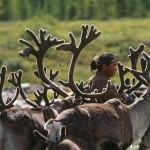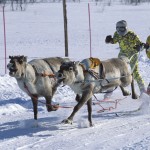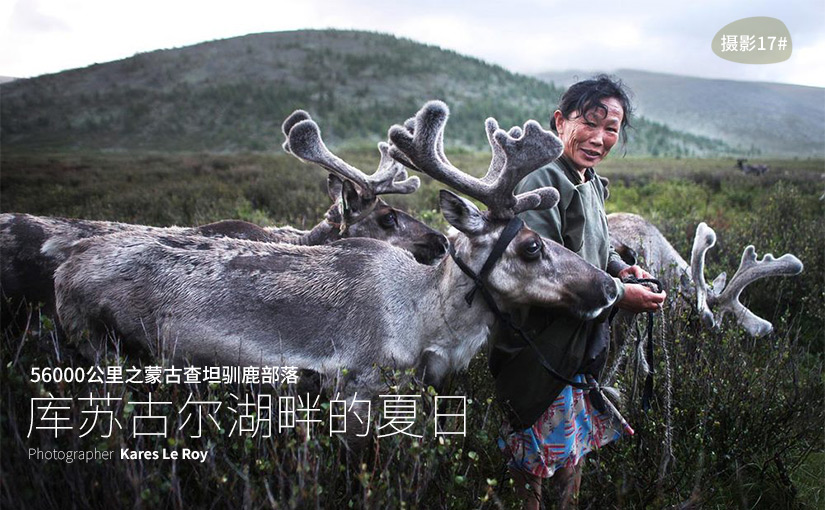法国摄影师Christophe BOISVIEUX拍摄了两个驯鹿民族,一个是蒙古的查坦,另一个是北欧的萨米。当驯鹿森林这个网站收录了越来越多的驯鹿民族资讯时,我会慢慢被这些不同地区的相同民族带到另一个想象的空间中去——
是不是在很久以前的某一个时刻,一支部落的族人决定在某一个地方开始分道扬镳,你们往北,他们往南,而我们就在此广袤森林里驻扎,不再偏离远走。于是就形成了今天横跨几个洲,内在几乎相同而外在不太一样的使鹿民族?
或许也只是因为地理环境的因素,决定了那个纬度的人们要与驯鹿共同生活的这个巧合。但无论如何,还是会因为这些影像记录而感受到蓝色星球的神奇和有趣。
更多查坦人图片请点击:http://www.christopheboisvieux.com/en/tsaatan-le-peuple-des-rennes
To the extreme north of Mongolia, within the confines of Siberia, the Tsaatan are a people on the margins of the world who perpetuate an ancestral way of life passed down since prehistoric times. These reindeer breeders (Tsaatan means literally the reindeer people) live nomadically in the red taiga forest to the rhythm of the seasons and live under canvas tents evocative of the American Indian tepees. They move around on reindeer-back, drink their milk, eat their meat and sell their wood, which they also sculpt with artistry. There are only today 35 Tsaatan families, roughly 200 people. Their existence is threatened with the extinction of their flocks, victims of in-breeding. Their livestock, which counted about 2000 heads thirty years ago, has been divided by three. Since the closing of the borders after the Second World War, the Tsaatan can no longer freely exchange reindeer and pastures with their brothers of the neighbouring republic of Tuva, with whom they share both a language deriving from Turkish and shamanistic beliefs. Projects involving artificial insemination, the implantation of Siberian or Canadian reindeer, organised by non governmental organisations does however leave room for real hope. The love of the Tsaatan for their reindeer is legendary. They give the young fawns affectionate names like “The Little Loved One”.The elder adorned with yellow scarves are seen as gifts from the gods and considered sacred.
在蒙古国的最北部与西伯利亚交接的地方,那儿查坦人还延续着祖先们从史前流传下来的生活方式。
这些驯鹿牧人常年跟随着四季的变化在红色针叶林中迁徙居住,并生活在一种类似于北美印第安人的那种充满古老气息的帆布帐篷里。
他们跟随着驯鹿迁徙,饮鹿奶,吃鹿肉并且销售一些他们自己做得木制工艺品。
如今这里仅剩下35个查坦家庭(将近200多人)。他们和他们的牲畜面临了生存与繁殖的威胁。他们的驯鹿在30年前有大约2000多头,但今天,只剩下三分之一。
第二次世界大战结束之后,查坦人便不能用驯鹿和比邻的图瓦国交换物品。图瓦国是一个与他们一样使用突厥语和信仰萨满的国家。一些关于驯鹿的人工繁项目,以及由西伯利亚或加拿大运送过来的驯鹿,也是由非政府机构来组织进行着,无论如何他们希望能为查坦人留有一定的生存空间。
查坦人对驯鹿的爱是非常传奇的。他们会给年轻的小鹿取一个深情的名字,比如“小爱人”。并在它们的鹿角上绑上黄丝巾,以显它们都是神赐予的礼物。
观看更多萨米人图片请点击:http://www.christopheboisvieux.com/en/paques-en-laponie
Easter, which coincides with the return of light and the end of the long polar night is the he most important holiday of the Lapps, a people without a state, torn apart between Sweden, Norway and Finland.
The Samis, as they call themselves, count nearly 50 000 souls, half of whom live in Norway, mainly around the towns of Kautokeino and Karasjok. It is in these towns, where the economy is built on the raising of reindeer, that Easter is celebrated with the greatest pomp. The whole holy week welcomes baptisms, communions and weddings that bring together at each occasion several hundred guests and maintain the community’s cohesion before the great springtime migration. Among the festivities, lasso-throwing tournaments, ice fishing competitions and joik (traditional Lapp songs) concerts also gather big crowds coming from all the Lapp provinces. But the star attraction remains the great reinder race where the richest breeders in all their finery rival each other in skill and elegance.
复活节这一天和拉普人结束极夜回归白昼的重要节日不谋而合。瑞典,挪威以及芬兰的人在这一天脱离了长夜的焦虑状态。
他们自称为萨米族,人数将近50000人,他们有一半居住在挪威的Kautokeino镇和Karasjok镇那里。这些小镇的经济来源都建立在饲养驯鹿之上。复活节是他们最盛大的节日,整个假期都在举行洗礼,婚礼和互相串门拜访,类似于我们的春节。这是他们春季大迁徙之前大家聚集交流的最好时光。
在庆典上,还会有各种比赛节目,汇聚了各个拉普地区的萨米人参与,有套索比赛,冰上钓鱼比赛,和传统音乐汇演等。
但最吸引人得还是驯鹿竞赛,许多经验丰富的驯鹿牧人可以在此切磋技艺,一较高下。
摄影师介绍
1960年出生于法国
从大学经济专业毕业后进入新闻界成为一名记者,游历了许多国家并与杂志和出版社合作发行了不少的旅游书籍。
其摄影作品获得过许多国际大奖也在巴黎现代艺术博物馆里展出过。
他的摄影题材总是围绕着人与神之间的关系,直至今天他拍摄了许多关于基督教、印度教、佛教等宗教题材的摄影作品。
Christophe BOISVIEUX个人网站:http://www.christopheboisvieux.com/
本文图片已获得摄影师Christophe BOISVIEUX的分享许可,如果需要转载此文请通过邮件/新浪微博留言咨询我。请大家尊重版权,谢谢合作。





























